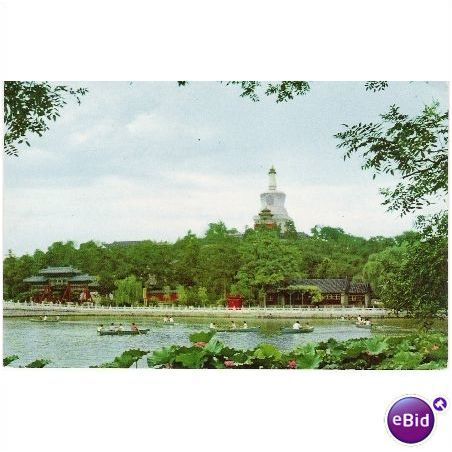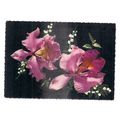Beijing (Peking) China Peihai (Beihai) Park 1970s
- Condition : Used
- Dispatch : 2 Days
- Brand : None
- ID# : 230634037
- Quantity : 1 item
- Views : 2
- Location : United Kingdom

- Seller : justthebook (+1703)
- Barcode : None
- Start : Thu 10 Jul 2025 22:03:27 (BST)
- Close : Run Until Sold
- Remain : Run Until Sold
More Listings from This Seller view all
Seller's Description
- Postcard
- Picture / Image: Peihai Park [now usually spelt Beihai in English] ('Views Around Peking') Probably 1970s
- Publisher: Foreign Languages Press, Peking, China
- Postally used: no
- Stamp: n/a
- Postmark(s): n/a
- Sent to: n/a
- Notes & Key words:
------------------------------------------------
Postage & Packing:
UK (incl. IOM, CI & BFPO): 99p
Europe: £1.60
Rest of world (inc. USA etc): £2.75
No additional charges for more than one postcard. You can buy as many postcards from me as you like and you will just pay the fee above once. (If buying postcards with other things such as books, please contact or wait for invoice before paying).
Payment Methods:
UK - PayPal, Cheque (from UK bank) or postal order
Outside UK: PayPal or Google Checkout ONLY please. NO non-UK currency checks or money orders (sorry).
NOTE: All postcards are sent in brand new stiffened envelopes which I have bought for the task. These are specially made to protect postcards and you may be able to re-use them. In addition there are other costs to sending so the above charge is not just for the stamp!
----------------------------------------------
Text from the free encyclopedia WIKIPEDIA may appear below to give a little background information:
*************
Beihai Park (simplified Chinese: ????; traditional Chinese: ????; pinyin: Beihai Gongyuán) is an imperial garden to the northwest of the Forbidden City in Beijing. Initially built in the 10th century, it is amongst the largest of Chinese gardens, and contains numerous historically important structures, palaces and temples. Prior to the end of the Qing Dynasty in 1911 this area was connected to the Forbidden City, but since 1925 it has been open to the public.
The Park has an area of more than 69 hectares, with a lake that covers more than half of the entire Park. At the center of the Park is an island called Qiónghuá (??) Island with a highest point of 32 m. In the north of the park there is a large pool called the Taiye Pool connecting the two other pools, which are called the Middle Sea and the South Sea respectively. Therefore the Taiye Pool is also called the Beihai.
Beihai literally means "Northern Sea". There are also corresponding "Central" and "Southern Seas" (Zhongnanhai). The complex of buildings around Zhongnanhai houses China's paramount leaders.
The Beihai Park, as with many of Chinese imperial gardens, was built to imitate renowned scenic spots and architecture from various regions of China; the taihu lake, the elaborate pavilions and canals in Hangzhou and Yangzhou, the delicate garden structures in Suzhou and others all served as inspirations for the design of the numerous sites in this imperial garden. The structures and scenes in the Beihai Park are described as masterpieces of gardening technique that reflects the style and the superb architectural skill and richness of traditional Chinese garden art.[1]
The Bai Ta (White Dagoba) is a 40 m high stupa placed on the highest point on Qiónghuá Island. Its body is made of white stone. Sun, moon and flame engravings decorate the surface of the tower. Destroyed in 1679 by an earthquake, it was rebuilt the following year, and restored again in in 1976, because of an earthquake which occurred at Tangshan City, near Beijing City. A reliquary, secreted inside the structure are Buddhist Scriptures, monk's mantles and alms bowl, and the bones of monks (their remains after cremation).
There are several renowned Buddhist temples located within Beihai Park, such as the Yong'an Temple (Temple of Everlasting Peace) and the Chanfu Temple.
On the north bank lies the Five-Dragon Pavilions, five connected pavilions with spires and pointed upswept eaves, which was built in the Ming Dynasty.
The Nine-Dragon Wall lies north of the Five-Dragon Pavilion. It was built in 1756 and is one of three walls of its kind in China. It is made of glaze bricks of seven-colors. Nine complete dragons playing in the clouds decorate both sides of the wall.
Also on the north bank is the Jingxin Room (Quieting Heart Room). It is a garden within the garden, and covers an area of more than 4,000 m².
The Circular Wall (Tuancheng) has as its main structure the Hall of Received Light (Chengguangdian), a spacious building with a double-eaved roof made of yellow glazed tiles bordered in green. Inside there is a 1.6 m tall Buddha presented to Emperor Guangxu by a Cambodian (Khmer) king. It is carved from a single piece of pure white jade inlaid with precious stones. The Eight-Nation Alliance damaged the statue’s left arm in the Battle of Peking in 1900.
In the Beihai Park, one could find Taihu rocks shipped from the Henan province and a variety of art collections ranging from jade jars from the Yuan-era to a collection of 495 steles bearing inscriptions by trees of hundreds of years old.[1]
Listing Information
| Listing Type | Gallery Listing |
| Listing ID# | 230634037 |
| Start Time | Thu 10 Jul 2025 22:03:27 (BST) |
| Close Time | Run Until Sold |
| Starting Bid | Fixed Price (no bidding) |
| Item Condition | Used |
| Bids | 0 |
| Views | 2 |
| Dispatch Time | 2 Days |
| Quantity | 1 |
| Location | United Kingdom |
| Auto Extend | No |




 for 1 item(s)
for 1 item(s)
















